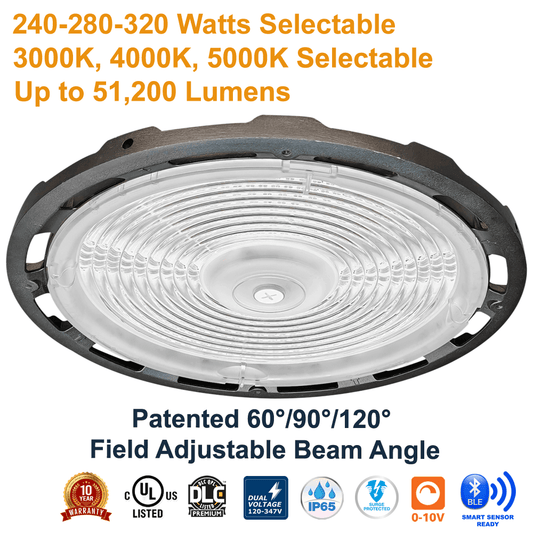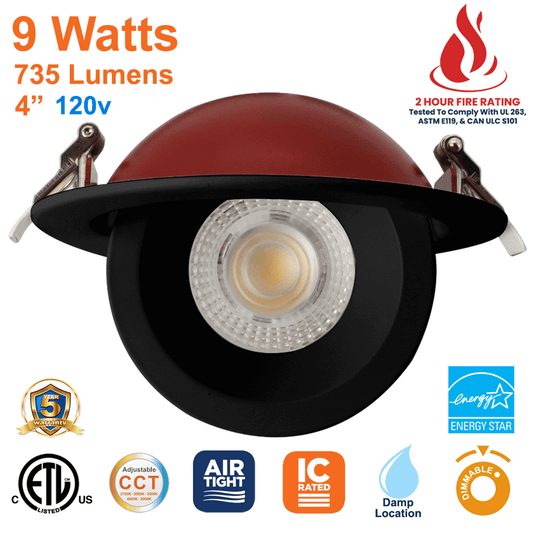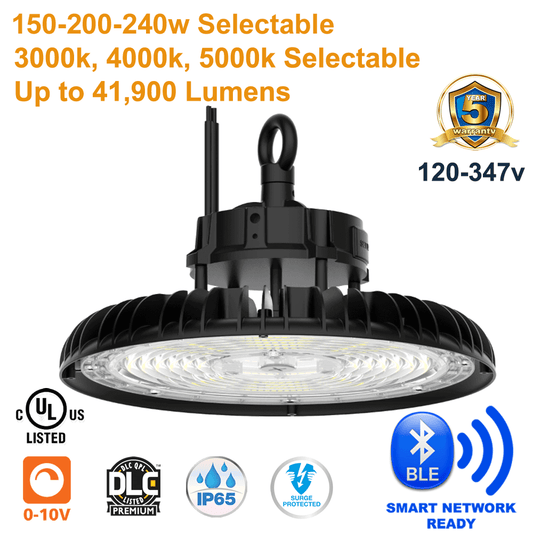In this article, we look at the world of the Lighting Control Module (LCM) with a special focus on today's advanced wireless networks. These innovative systems offer a smarter, simpler, more efficient way to manage lighting in commercial and industrial environments. Through advanced technologies like LED dimmer modules, and Bluetooth-enabled devices, lighting control systems are creating adaptable, energy-efficient environments that respond to the needs of their occupants.
Whether you're interested in the basics of lighting control, the advantages of wireless over wired systems, or the specifics of designing a commercial lighting control system, let's look at the path forward.
Table of Contents
- What Is A Lighting Control Module?
- What Does A Lighting Control System Do?
- What Role Does A Lighting Control Module Play in A Lighting Control System?
- Why Are Lighting Control Systems A Good Idea In Commercial & Industrial Facilities?
- What Are The Types Of Industrial Lighting Control Systems, And How Does Each Work?
- How Do You Design A Commercial Lighting Control System?
- What Is A Lighting Control Zone?
- What Role Does Bluetooth Mesh Play In Today’s Networked Lighting Control Systems?
- Is Bluetooth BLE Mesh Lighting Control Reliable?
- How Do Wireless Bluetooth Mesh Networked Lighting Controls Work?
- What Is The Difference Between Wired And Wireless Lighting Controls?
- What Makes Wireless Lighting Controls The Best Choice For Lighting Control In A Commercial Building?
- Frequently Asked Questions
What Is A Lighting Control Module?
A Lighting Control Module is the cornerstone of modern lighting control systems. It's an intelligent device designed to regulate the intensity, timing, and operation of lighting in a space. From simple dimmer switches for LED lights to networked wireless light control modules, these devices are at the heart of building energy-saving strategies.
What Does A Lighting Control System Do?
At its core, a lighting control system provides flexibility, energy efficiency, and enhanced control over the lighting environment. By integrating components like occupancy sensors and smart lights, these systems can automate lighting based on occupancy, daylight availability, and specific user settings, leading to significant energy savings and improved comfort for occupants.
What Role Does A Lighting Control Module Play in A Lighting Control System?
Lighting Control Modules serve as the brain of today's lighting control system. They receive input from sensors or user inputs and then direct light fixtures accordingly. This might involve dimming LED lights to a desired level or turning lights on and off based on room occupancy, which is crucial for optimizing the system's energy efficiency and user satisfaction.
Why Are Lighting Control Systems A Good Idea In Commercial & Industrial Facilities?
In settings like warehouses or office buildings, lighting accounts for a substantial portion of energy consumption. A lighting control system with components like high bay sensors can drastically reduce this consumption. These systems not only cut down on energy costs but also contribute to a facility's sustainability goals by reducing its carbon footprint.
What Are The Types Of Industrial Lighting Control Systems, And How Does Each Work?
Industrial lighting control systems vary from simple manual controls to advanced networked systems. The latter, including networked lighting controls, offer greater flexibility and efficiency by allowing for centralized management of lighting across a facility. These systems can integrate various control strategies, such as scheduling, occupancy sensing, and daylight harvesting, to achieve optimal performance.
How Do You Design A Commercial Lighting Control System?
Designing a commercial lighting control system requires a thorough understanding of a space's lighting requirements and the goals of the lighting control strategy. Key considerations include the selection of appropriate control devices, the layout of lighting zones, and the integration of smart lighting solutions for enhanced control and efficiency. The design process often involves collaborating with lighting professionals to ensure that the system meets the specific requirements of the space while maximizing energy savings.
What Is A Lighting Control Zone?
A Lighting Control Zone is a specific area within a building or space where lighting can be controlled independently of other areas. This concept is crucial for creating adaptable lighting systems that can meet the diverse needs of different areas within a building. By defining zones, a system can more effectively manage energy use, enhance comfort for occupants, and respond dynamically to changes in occupancy or ambient light levels.
What Role Does Bluetooth Mesh Play In Today’s Networked Lighting Control Systems?
Bluetooth Mesh has emerged as a pivotal technology in networked lighting control systems, offering scalability, reliability, and security. This wireless communication standard allows for the creation of large networks of devices that can communicate with each other, making it ideal for lighting control in commercial and industrial settings. The unleashing of Bluetooth Low Energy (BLE) has revolutionized networked lighting controls by facilitating more efficient, flexible, and customizable lighting solutions.
Is Bluetooth BLE Mesh Lighting Control Reliable?
Yes, Bluetooth BLE Mesh is considered highly reliable for lighting control. It provides robust, low-latency communication between devices, ensuring lighting commands are executed promptly and accurately. This reliability, combined with the technology's low power consumption and extensive range, makes BLE Mesh an excellent choice for modern lighting systems, particularly in large commercial or industrial facilities where reliability is paramount.
How Do Wireless Bluetooth Mesh Networked Lighting Controls Work?
Wireless Bluetooth Mesh networked lighting controls create a network of interconnected devices where each device communicates with its neighbours. This mesh network enables information to be relayed across the system, allowing for the controlling of light fixtures even if they are not directly connected to a central controller. This approach enhances system flexibility and scalability, enabling the implementation of advanced lighting control strategies across vast areas without the need for extensive wiring.
What Is The Difference Between Wired And Wireless Lighting Controls?
The main difference between wired and wireless lighting controls lies in their installation and operational infrastructure. Wired systems require physical connections between components, making installation more complex and potentially costly. Wireless systems, on the other hand, communicate via Bluetooth BLE or radio frequencies, offering easier installation and greater flexibility in system design and expansion. Wireless controls also facilitate retrofitting in existing buildings, where running new wires may be impractical or disruptive.
What Makes Wireless Lighting Controls The Best Choice For Lighting Control In A Commercial Building?
Wireless lighting controls offer unparalleled advantages for commercial buildings, including flexibility in installation and scalability. They allow for easy system expansion or reconfiguration without extensive rewiring. Furthermore, wireless systems support a wide range of control strategies, from occupancy sensing to scheduling to daylight harvesting to peak demand response, which can be tailored to the specific needs of different rooms and zones within a building. Additionally, integrating with other building systems and IoT devices enhances overall building efficiency and occupant comfort. The transition towards wireless also aligns with the growing emphasis on smart buildings, where seamless integration of various systems can lead to significant operational efficiencies and energy savings.
Frequently Asked Questions About Lighting Control Modules
Can Lighting Control Modules Be Used With Any Type Of Light Bulb?
Yes, most Lighting Control Modules are designed to be compatible with a wide range of light bulbs, including LED, incandescent, and fluorescent. However, it's essential to check the specific module's compatibility to ensure optimal performance, especially with LED dimmer modules, which usually require dimmable bulbs.
How Do I Install Lighting Controls In My Facility?
Installation procedures can vary depending on the type of Lighting Control Modules you wish to install and the existing infrastructure of your facility. Generally, with LED Lighting, it involves wiring the Light Control Modules to your fixtures. For wireless systems, you'll also need to set up the network and pair the modules with your control interface. Consulting with a professional installer is recommended for the best results.
Are Lighting Control Modules Energy Efficient?
Absolutely! Lighting Control Modules are designed to increase energy efficiency by allowing precise control over lighting levels and reducing energy consumption during periods of low occupancy or high ambient light. Strategies like scheduling, occupancy sensing, and daylight harvesting contribute significantly to energy savings.
Can Lighting Control Modules Integrate With Other Building Management Systems?
Yes, many Lighting Control Module systems are designed to integrate seamlessly with other building management systems (BMS), such as HVAC and security, through protocols like BACnet. This integration enables a more holistic approach to building management, enhancing efficiency and occupant comfort.
What Is The Range Of A Wireless Lighting Control Module?
The range of a wireless Lighting Control Module can vary based on the technology used (e.g., Bluetooth Mesh, Wi-Fi, Zigbee). Bluetooth Mesh, for instance, extends the range significantly by allowing messages to hop from one device to another, effectively covering large areas like commercial buildings or industrial facilities. In fact, one of Keilton's latest Bluetooth Mesh Lighting Control Modules can communicate over distances of up to 300 feet.
How Do I Program A Lighting Control Module?
Programming a Lighting Control Module typically involves using a software application or web interface provided by the manufacturer. At LED Network we work with the Keilton + autani APP, which provides easy and fast programming. Users can define settings such as lighting schedules, set up zones, and configure responses to sensors or manual inputs.
Can Lighting Control Modules Work Outdoors?
There are Lighting Control Modules specifically designed for outdoor use, equipped to handle varying weather conditions and temperature extremes. These modules can control outdoor lighting fixtures, enhancing security and energy efficiency outside your facility. Look for Lighting Control Modules that carry an IP65 rating.
What Is The Lifespan Of A Lighting Control Module?
The lifespan of a Lighting Control Module can vary, but most are designed to last for several years under normal operating conditions. The longevity can be influenced by factors such as the environment in which it's installed and the quality of the device.
Do Lighting Control Modules Require Maintenance?
Lighting Control Modules generally require minimal maintenance. Keeping the software up to date and occasionally checking the system for any issues is usually sufficient. Wireless systems, in particular, benefit from being able to diagnose and address many potential problems remotely.
How Much Can I Expect To Save By Installing A Lighting Control Module?
The amount you can save by installing a Lighting Control Module depends on various factors, including the size of your facility, the type of lighting used, and how the system is configured. However, significant energy savings of up to 30-50% are not uncommon, with the added benefit of reduced maintenance costs and improved occupant comfort contributing to the return on investment.
By addressing these frequently asked questions, we aim to provide a clearer understanding of today's Lighting Control Module and the benefits lighting controls bring. Whether you're considering upgrading your existing lighting system or designing a new installation, these insights can help you make informed decisions about incorporating smart lighting solutions into your commercial or industrial facility.























